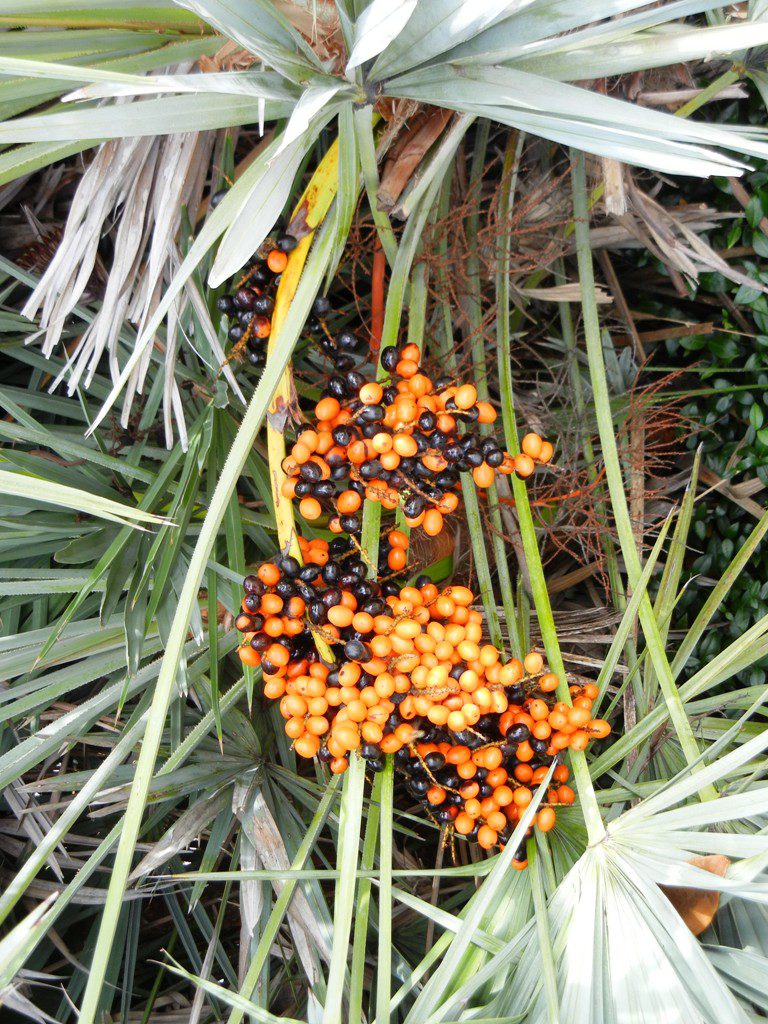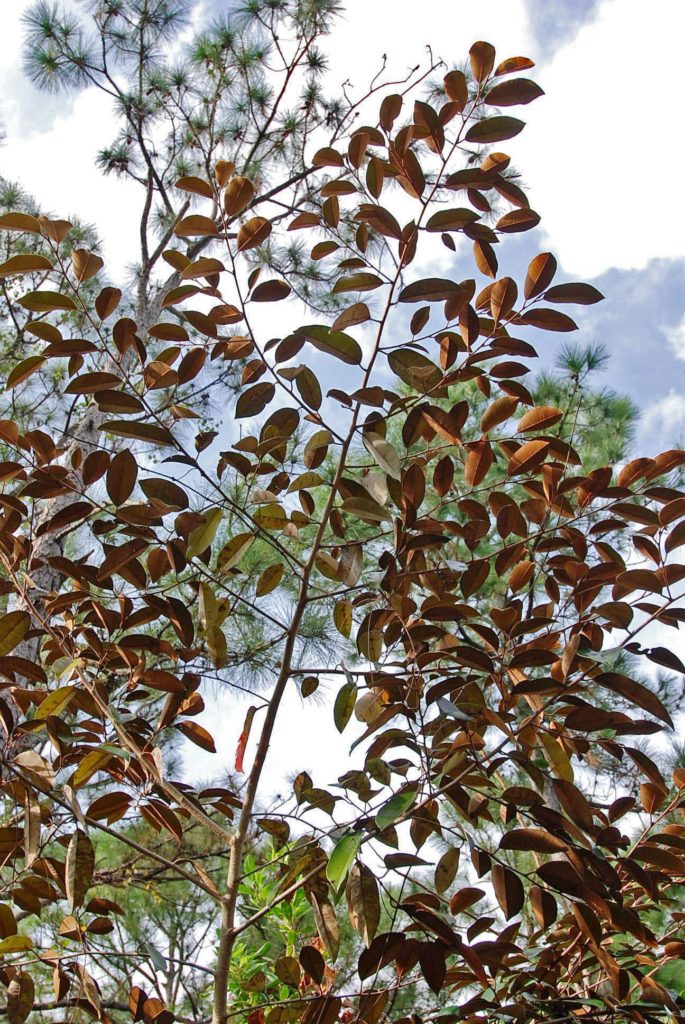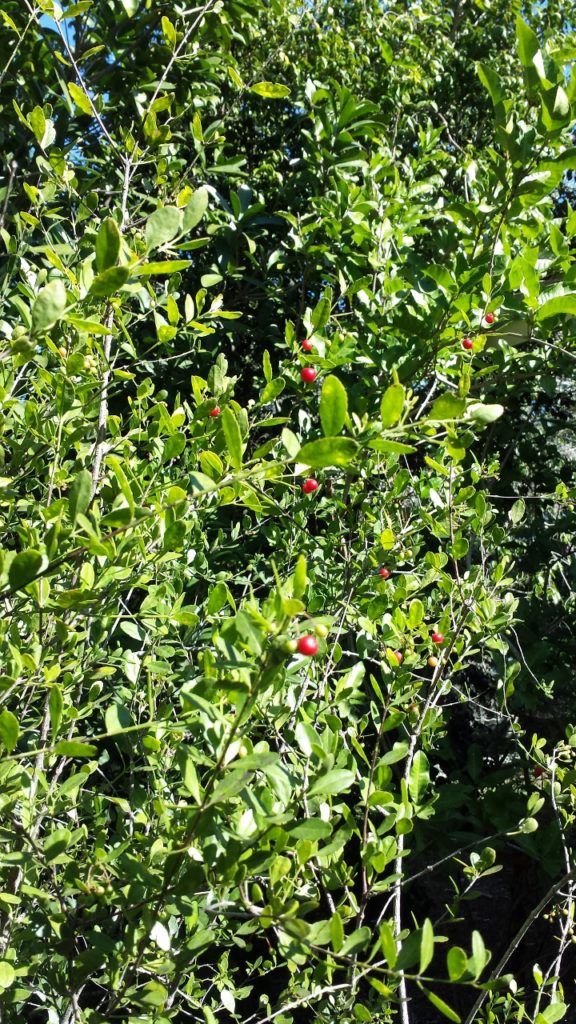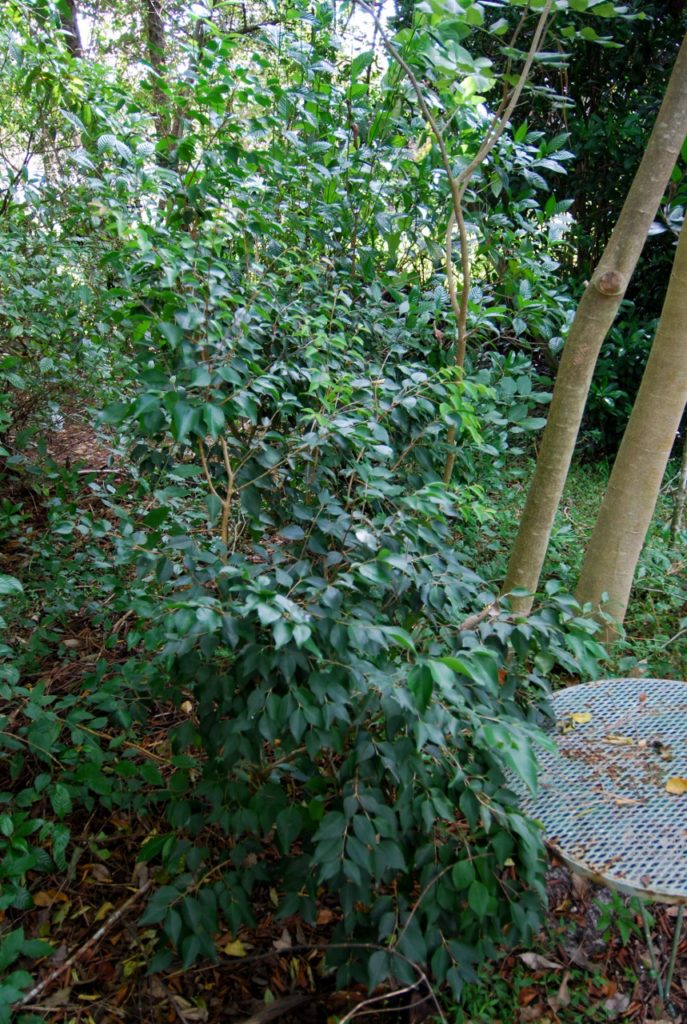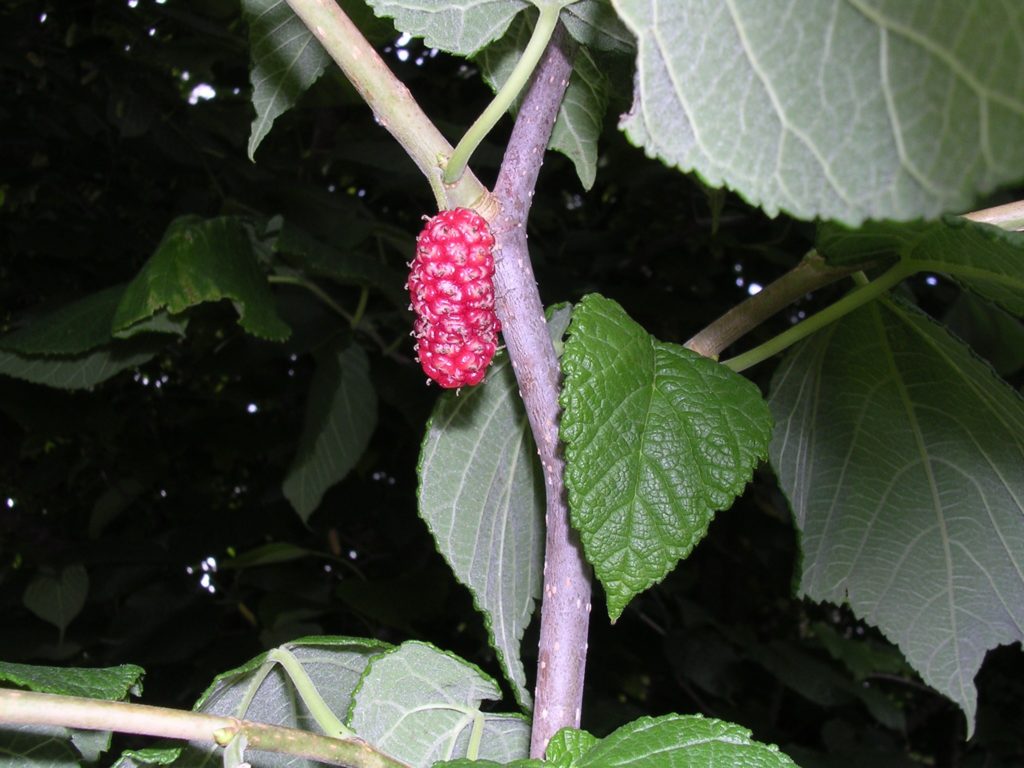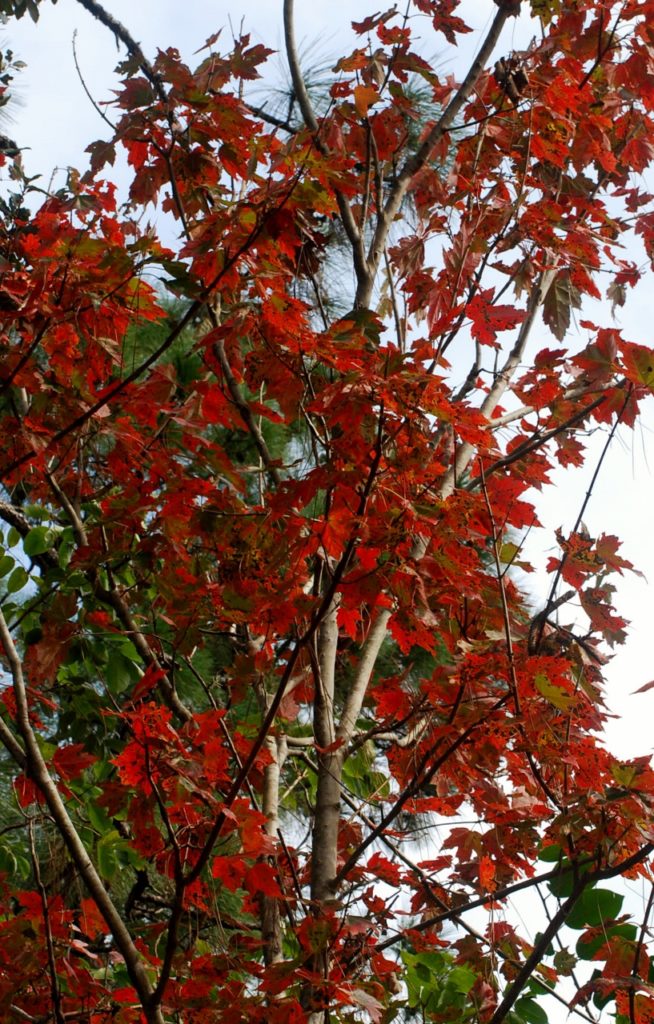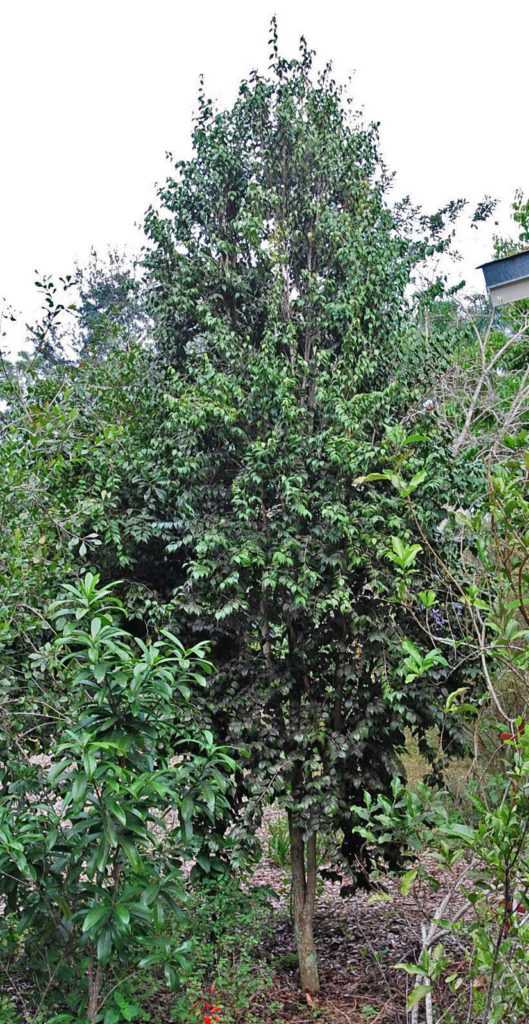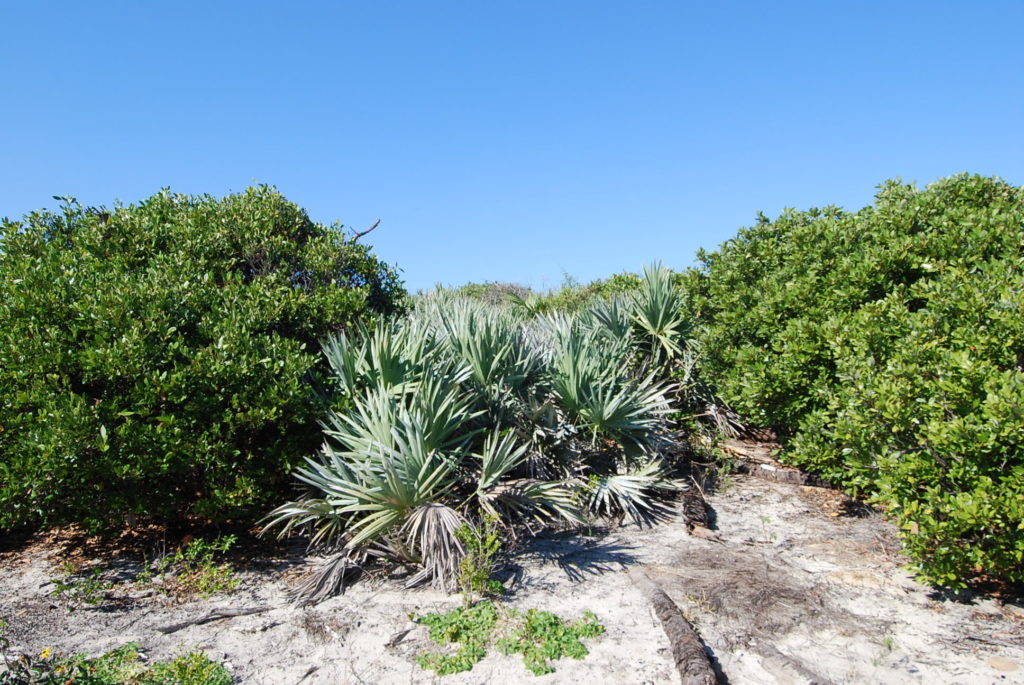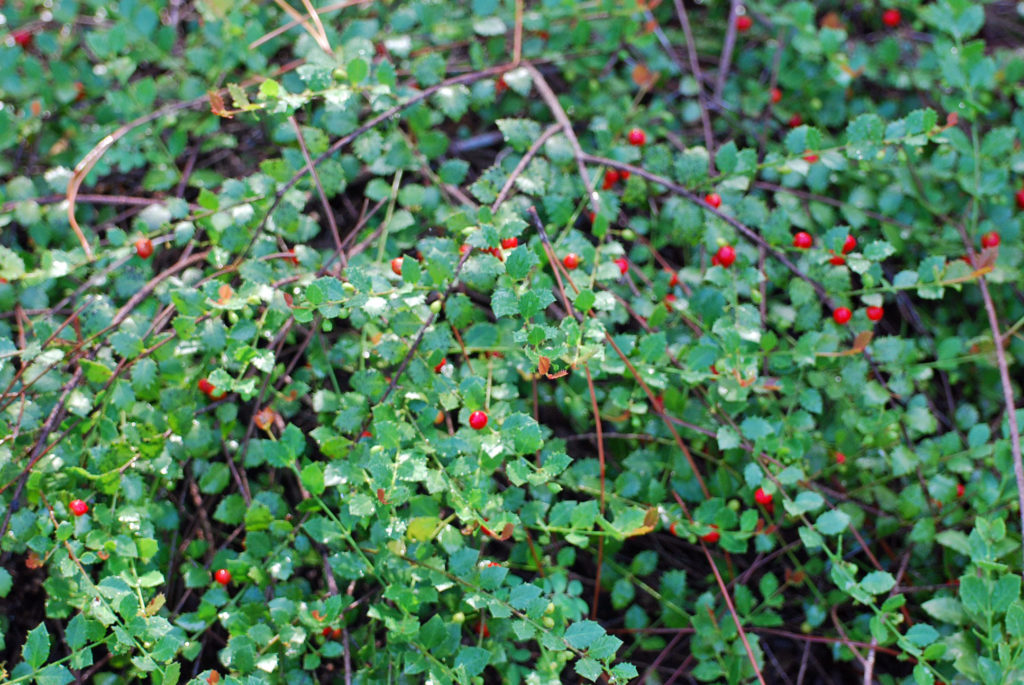Scrub Palmetto
Sabal etonia
Scrub Palmetto is an unusual palm that is found only from just below Jacksonville to Miami Dade County along the coast and also the Lake Wales Ridge of central Florida. It looks a lot like a Sabal Palm, yet has shorter, more twisted leaves and doesn’t develop a trunk.
The total height is rarely over four feet. The sweet, half inch black fruit is edible and is a good wildlife food. The central bud can be eaten as heart of palm, yet this kills the plant. Better to eat some of the many Sabal Palm seedlings that often come up in unwanted places.
This is a tough plant that is very drought tolerant and can take some salt air, but no salt water flooding. It grows in deep scrub soils where there is some organic matter and richness. Juno Hills Preserve is a great place to see it in Northern Palm Beach County.
Here it is mixed with Saw Palmetto, Scrub Redbay, Scrub Oaks, Necklace Pod, Saffron Plum, Hercules Club, Wild coffee, Dune Sunflower, Slash Pine, Beautyberry, Sand Pine, Beach Cocoplum and Wild Lime. In the landscape, you can mix in many other plants as long as it gets plenty of sunlight.
This is a great plant if you want a palm that stays low and never needs to be cut back. Try it near a building or the center of a circular driveway. Butterflies and bees will visit the flowers. Bees will not sting, which causes their death, to protect a flower. Nests, which can be anywhere, are another matter.
Click for more info. And more info.
Saw Palmetto
Serenoa repens
Saw Palmetto is native along the coast of the Southeastern United States and all across Florida including some of the Florida Keys. It is tolerant of much salt air and occasional short term salt water flooding.
Once established, this is a very drought tolerant plant that can live from scrub habitat to seasonally flooded wetlands. Soil should have some organic matter or the plants will stay very small.
In rich woodlands the Saw Palmetto may reach 15 or more feet in height. Fire in natural settings will bring the height down. Killing the growing tip does not kill the plant as in most other palms.
This makes the Saw Palmetto a good choice for residential or commercial plantings where the height can be controlled by cutting once a year or two.
The saw tooth edges of the leaf stems will cut the skin, a feature that makes this plant a great security barrier. A mass planting that rolls over hills or fills in between Slash Pines is gorgeous. The fruit turn from green to gold and finally black.
Deer, bears, raccoons and other wildlife including alligators and humans eat the sweet black fruit. This glistens with sugar and healthy oils when ripe and has the flavor of sweet balsamic vinegar.
I enjoy eating a dozen or more when hiking and have never had a bad reaction to them. They are not good in salad though, the taste just doesn’t go with vinegar dressing.
When you cut the plants back in your landscape, pull out the central bud of the cut pieces and use the soft interior as you would hearts of palm. If you keep bees, Saw Palmetto honey is one of the most flavorful.
There is a range in leaf color from solid green, light blue, deep blue to almost silver. Silver Saw Palmetto is rare, blue is more common. Each plant has its own color and if you see a large patch of one color in nature, it is from a plant that has spread out over many years.
This is a plant that can be found in full sun to the moderate shade of an oak tree. Try mixing with Beautyberry, Coralbean, Hercules Club, Wild Coffee, Myrsine, Dahoon Holly, Redbay, Necklace Pod, Scrub Palmetto, Beach Cocoplum, Blackbead and other shrubs and trees that will grow tall and not be drowned out by the Saw Palmetto.
It can be planted near a building when cut back regularly to keep it in bounds. When planted in masses away from buildings, roads and walkways, mowing around it is easy and pruning won’t be required very often, if at all.
How about a simple group of Slash Pine, Saw Palmetto and any of the above mentioned? Just place so that you can easily mow around them and leave some open portions to play in or for a bench to view wildlife from .
Click for more info.
Satin Leaf
Chrysophyllum oliviforme
Satin Leaf is native from the Florida Keys up to Merritt Island. It is found in coastal hammocks where the soil is rich, moist, well drained and no longer salty; especially in the vicinity of Mangroves.
Satin Leaf can reach up to 50 feet in height. It can survive some cold, yet freezing temperatures may kill it to the ground. Shoots will sprout from the roots and a new leader can then be selected.
The shiny, dark green upper leaf surfaces and rusty undersides of Satin Leaf will dazzle you as they shimmer in the wind. Birds are easy to observe as they move through the evenly spaced branches while eating the olive sized fruit.
This is edible and contains enough chicle to accumulate into a ball of gum after placing several in your mouth and spitting out the pits. It has a pleasant prune flavor.
You may not want to plant this tree close to walkways as the fruit will stick to your shoes and find its way onto your white livingroom rug. You can shake the tree and most of the ripe fruit will fall and can easily be swept up.
Find a protected location to plant and mix with other hammock trees like Paradise Tree, Mastic, Lancewood, Pigeon Plum, all of the Stoppers and an understory of Wild Coffee, Marlberry, Coontie, Wild Plumbago, Beautyberry and Basket Grass.
When planting Satin Leaf, you will find that the roots have circled many times inside of the pot. Do not cut them! Just unravel the roots and place the ends inside of an extra deep hole.
Fill in carefully so that these are fully stretched and go down deep with the base of the plant at ground level.
Mix in lots of organic matter and form a ring with the extra soil around the top of the hole. This will wash in and take the place of the organic matter as it oxidizes. It also makes watering easy by preventing the water from running off.
Click for more info.
Rhacoma
Crossopetalum rhacoma
Rhacoma or Maidenberry is a native shrub with a fountain-like growth of arching stems, rising from a base of low growth, that may reach eight feet tall. Sometimes it grows as a low groundcover only 12 inches high. You can force this by trimming off the taller shoots.
The small red berries occur most of the year. These are eaten by birds and are not poisonous, in fact they are quite sweet.
Rhacoma is found in some of the Keys and Miami Rocklands in limerock or sand. It is not tolerant of salt air or water yet grows near the edge of salt marshes just above the high water line. Here, the wind gives it a bonsai-like shape.
It is surprisingly tolerant of soil with pea or rice gravel in it such as near a driveway or house. These gravels are made of crushed lime rock.
Maidenberry is a tough plant that grows well through Palm Beach County in full sun and rich soil. It needs a little fertilizer to look its best.
The fountain-like growth and red berries make this a good rock garden plant when mixed with low ground covers. These may include Quailberry, various Cacti, Pineland Petunia, Havana Scullcap, Melanthera pumila, Beach Alternanthera, Beach Creeper, Coontie, and Sea Purslane to name a few.
Larger plants to mix with Rhacoma include Silver Palm, Key Thatch, Florida Thatch Palm, Buccaneer Palm, Sea lavender, Joewood, Lignum Vitae, Black Torch and other shrubs of the Keys.
Click for more info.
Red Stopper
Eugenia rhombea
Red Stopper is a very rare shrub that grows to twelve feet over a long period of time. It is found in the upper keys in moist, rich soil and will need these conditions in the home landscape.
The plant looks very similar to White Stopper although the leaves are more round at the base, smaller, and are closer together. They also tend to lie in the same plane rather than wander about the stem the way White Stopper does.
The berries of Red Stopper go from green to yellow to orange and finally black. Birds love them and they are astringently sweet and edible. The slow growth makes this a good choice for a low shrub that will need only yearly pruning to stay below three feet.
Establishment takes a long time, so keep up with the weekly watering for about a year until the plant no longer wilts when cut off from the watering routine.
This is a great plant to mix with other low shrubs on the edge of a hammock planting. It is not salt tolerant though and should be planted well back of the dune and protected by other trees and shrubs.
Try mixing with Wild Coffee, Bahama Wild Coffee, Myrsine, Marlberry, Florida Boxwood, Spanish Stopper, RedBerry Stopper, Wild Cinnamon, Soldierwood, Crabwood, Pineland Privet, Florida Privet, Tetrazygia, Bitterbush, Blolly, The Guettardas and Black Ironwood.
Click for more info on Red Stopper. And here to compare with White Stopper
Red Mulberry
Morus rubra
Red mulberry is found in coastal and inland hammocks throughout most of Florida including Palm Beach, Broward and Dade counties. It is also found in most of eastern North America. It will reach a height of 40 feet.
Salt water and direct salt air are not tolerated, yet Red Mulberry will do well when planted behind and is shielded by other coastal trees.
The flowers tend to be male or female on different trees and are wind pollinated. You don’t have to have both for fruit, but you do if you want viable seed. A few flowers may have both sexes.
The fruit turns from red to reddish black in April and May and is a favorite for migrating cedar waxwings, kids and local birds. It is sweet and can be eaten raw or in pies.
The large leaves of red mulberry drop in late fall and are replaced in early spring. They are soft and quilted and may be round with a pointed tip, three lobed or mitten shaped. The exotic Mulberries are rough to the touch.
Red Mulberry leaves are eaten by many different kinds of insects that provide food for young birds.
Although the appearance of shredded leaves and two months of bare stems in winter seems like a lot to accept, it is well worth it when young birds survive and stay in your yard. Iguanas like the leaves too, so make sure they don’t feel welcome.
The yellow roots spread out like a Ficus and should be kept away from structures. Mix Red Mulberry with Oaks, Hackberry, Florida Elm, Red Maple, or other inland trees. Coastal hammock species like Gumbo Limbo, Mastic, Pigeon Plum or Paradise Tree are also good companions. Leave it bare underneath with fallen leaves as a ground cover.
Click for more info.
Red Maple
Acer rubrum
Red Maple, also called Swamp Maple, may grow to over 50 feet tall in South Florida. It has a straight trunk up to two feet in diameter with colorful lichens painting the bark.
Color starts around Christmas time when the old leaves turn red, orange, yellow and purple. Shortly after leaf fall, the flower buds begin to open into pink clusters.
The seeds start out red and turn pink as they mature into one inch winged samaras which occur in pairs and form clusters. These mature by early February and are followed by young leaves that may be light green or bright red. Most leaves are four inches long and have three lobes.
Red Maple likes moist soil but can tolerate fairly dry soil once fully established. It is not tolerant of salt air or water, yet can tolerate short periods of freshwater flooding.
It naturally grows along the edge of wetlands, not in the water like Cypress or Pond Apple. Healthy older trees can tolerate some drought. It is best to have moist soil though.
Squirrels and chipmunks love to eat the ripe seeds. several squirrels may be on the tree at one time. Deer and rabbits will eat the young growth. The seeds are also tasty if roasted See this link for more info.
This is a wide ranging tree from Maine to Dade County Florida and west to Texas. Always get trees grown from local seed so that you don’t end up with a plant from a northern state that will be dormant six months of the year. In South Florida, it is bare for only four to six weeks.
Red Maple mixes with many wetland species. Trees include: Cypress, Pond Apple, Red Bay, Water Hickory, Popash, Carolina Willow, Sweetgum, Sweetbay, Loblolly Bay, Laurel Oak, Live Oak, Slash Pine, Hackberry, Florida Elm, Paurotis Palm and Florida Royal Palm.
Shrubs include: Virginia Willow, Buttonbush, Wax Myrtle, Coccoplum, Elderberry, Saw Palmetto, Myrsine, Firebush, Marlberry and Wild Coffee.
Ferns and wildflowers make a great understory. Giant Leather Fern, Swamp, Marsh, Hottentot and native Boston Ferns mixed with Yellow Canna, Pickerelweed, Duck Potato, American Crinum Lily and Thalia will produce an enchanting combination.
Click for more info. And for more info.
Redberry Stopper
Eugenia confusa
Redberry Stopper is the most beautiful of all the stoppers. The one to two inch dark green leathery leaves have a long drip tip that makes this tree seem tropical.
It can be found naturally from the Keys to Brickell Hammock and then on Sewell’s Point in Martin county. It may not occur there anymore due to development.
This is a narrow tree that may grow to thirty feet, but is usually 20 feet or less. It fits into a tight spot near the house and mixes well with other plants. This makes a great specimen for the front yard.
The small white flowers bloom in clusters and smell sweet. The pea sized berry is bright orange, sweet and attracts many birds that seem to take turns while feeding.
Don’t worry about seedlings coming up everywhere. Few seeds germinate, and if they do, the growth is very slow at one inch per year the first to third year and just a few inches a year after that. An eight foot tree may be ten or more years old.
Soil should be full of organic matter and mixed with high grade fertilizer containing micronutrients. When planting, make sure that the roots are carefully pulled apart to upset circling roots.
Salt tolerance is low, but drought tolerance is high once fully established. Plant well back from the ocean. If you visit “Vizcaya” in Miami, you will see many of these beautiful trees in the parking area. Check out parks in the vicinity and you will find some real specimens.
Redberry Stopper is great used alone, yet it is beautiful planted with other trees and tall shrubs. These include Paradise Tree, Gumbo Limbo, Pigeon Plum, Marlberry, Simpson, Red, Spanish and White Stoppers, Soldierwood, Cinnamon Bark, Krug’s Holly, West Indian Cherry, Bahama Strongbark, Crabwood and Milkbark.
The understory can be any combination of Shiny Wild Coffee kept low, Bahama Wild Coffee, Snowberry, Beautyberry, Coontie, Beach Creeper, Key Thatch and Silver Palms, Native Plumbago and wildflowers.
Click for more info.
Red Bay
Persea borbonia
There are three kinds of Red Bay in Florida. The first is Scrub Red Bay or Silk Bay, Persea borbonia var. humilis. It is shown on the left and right of this picture and is found in the lower areas of scrub habitat.
This is a dense tree up to 30 feet. It occurs primarily in South and Central Florida and may have leaves with a light to dark coppery underside.
Along the coast is a tall Red Bay, Persea borbonia, with leaves that have a light green underside. It may reach a height of 50 feet.
Inland swamps contain Swamp Bay, Persea palustris. The leaves are slightly larger than the other two and are a light whitish green color underneath. All have leaves that are around four to five inches long. Red Bay and Swamp Bay occur from Delaware south through most of Florida.
Swamp Bay is the only one that requires moist soil, although it can tolerate average soil with organic matter once established. The Silk Bay shown in this picture is growing in dry soil within Juno Hills Natural Area in northern Palm Beach County. This is a rare site where scrub and coastal habitat meet.
Redbay Ambrosia Beetle-Laurel Wilt Pathogen is a new beetle pest carrying a fungal disease that kills Red Bays and Avocados. This beetle arrived here from India in 2002, hitching a ride in packing material.
Older trees die soon after the beetle bores into the trunk and spreads the fungus carried in its mouth into the sapwood. The beetle larvae feed on this fungus. Look for frass coming out of the trunk and dark brown leaves. Click for more info.
The beautiful Palamedes Swallowtail Butterfly larva feeds on young Red Bay leaves. It is important to have these trees available to them or we could lose these butterflies as well.
Although many naturally occurring Red Bays are dying from Laurel Wilt, I feel that Red Bays planted in far flung locations, such as in yards miles from the coast or natural wetlands may escape infestation. You will want to be far from Avocado trees or groves too, so as not to provide a possible pathway to these food trees.
So please don’t avoid planting Red Bays because of the possibility of this disease. We may need the seeds of your trees later, when the disease has passed through and reforestation of Red Bays commences.
The leaves of Red Bay can be used instead of commercial bay leaves in cooking. Wreaths made of them provide a pleasant aroma at Christmas time. The bark provides good support for air plants and orchids the way Live Oak does.
Try planting Red Bay instead of or with Live Oak. It looks similar, yet has a darker brown bark and larger leaves. The pea sized fruit, that looks like a small Avocado, is eaten by birds and is harmless, yet not tasty to humans. The insects found on the leaves and hidden in the bark are food for young birds. Native insects cause little noticeable damage.
Persea borbonia, which is the larger of the three, occurs along the coast back far enough to avoid much salt air and saltwater flooding. It mixes well with other coastal trees and shrubs. Try combining it with Live Oak, Paradise Tree, Pigeon Plum, Mastic, Lancewood, Sea Grape and Hackberry.
The understory can be Wild Coffee, Marlberry, Snowberry, Coontie, Spanish, White and Simpson Stopper, Boston Fern and Red Salvia.
Swamp Red Bay goes well with Red Maple, Virginia Willow, Laurel Oak, Cypress, Slash Pine, Buttonbush, Carolina Willow, Sweetbay, Giant Leather, Swamp, Marsh and Hottentot Ferns.
Silk Bay looks great with Hercules Club, Saw Palmetto, Tough Bumelia, all of the Scrub Oaks, Wild Lime, Wild Coffee, Scrub Palmetto, Necklace Pod, Blolly and other scrub species.
Click for more info.
Quailberry
Crossopetalum ilicifolium
Quailberry, also known as Christmasberry, is native to parts of the Keys and the Miami Rocklands. It is a low shrub of only six inches that does well throughout Palm Beach County.
Quailberry will grow into a two foot diameter mat of tiny green leaves and has bright red berries almost all year. The leaves have sharp lobes which make them look like a holly leaf.
Full sun is required, although partial shade will do. Birds eat the berries which are mildly sweet and edible. This is not a holly, but a member of the Bittersweet family. The low height and slow growth rate make this a superb groundcover.
The soil should be rich with fertilizer and organic matter to produce the most beautiful plants. We lay down a rubbery, easy to replace, weed cloth and cut a hole to place the plant in. Mulch was added last. Once established, it is very drought tolerant and will survive in nutrient poor soil, yet not look its best.
Use quailberry in a rock garden along with Lignum Vitae, Beach Creeper, Longstalk Stopper, Thatch Palms, Coontie, Chapman’s Cassia, Joewood, Rhacoma, Twinflower, Havana Scullcap and Locustberry.
Click here for more info.

